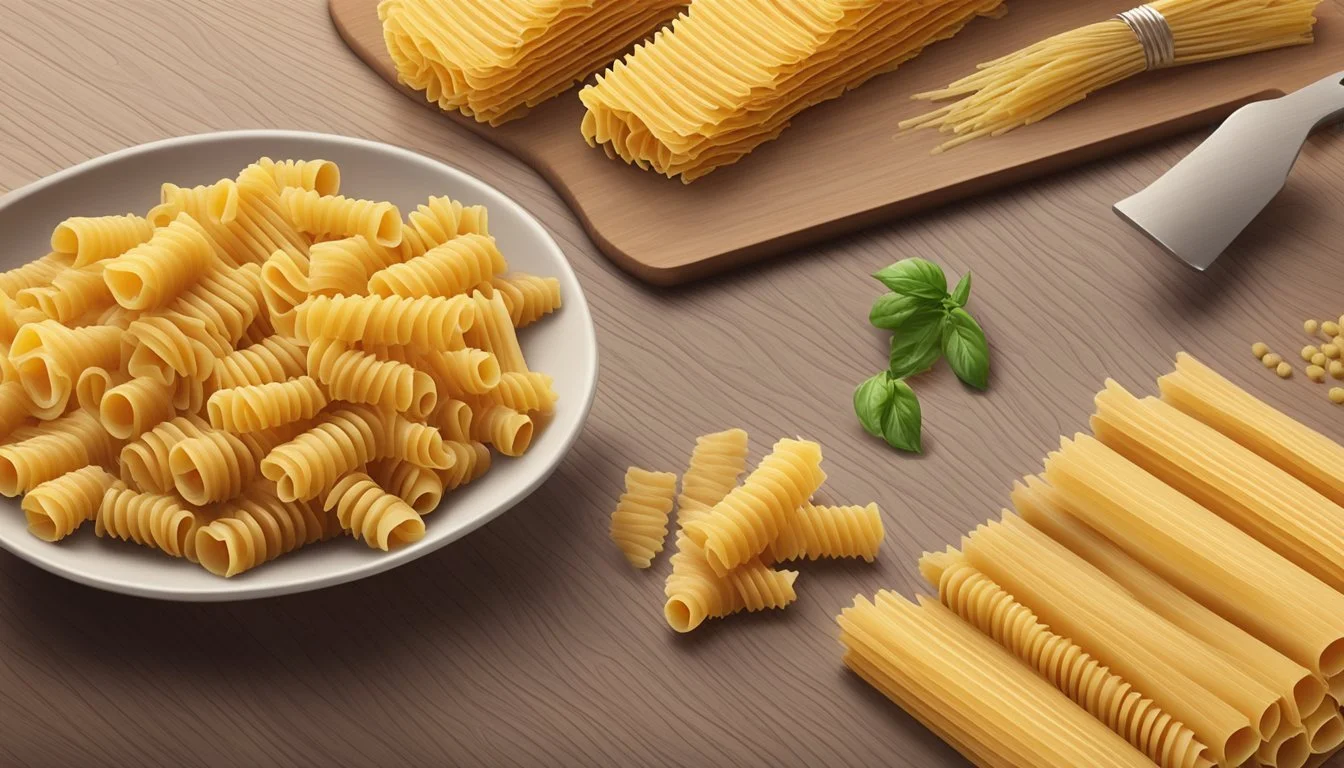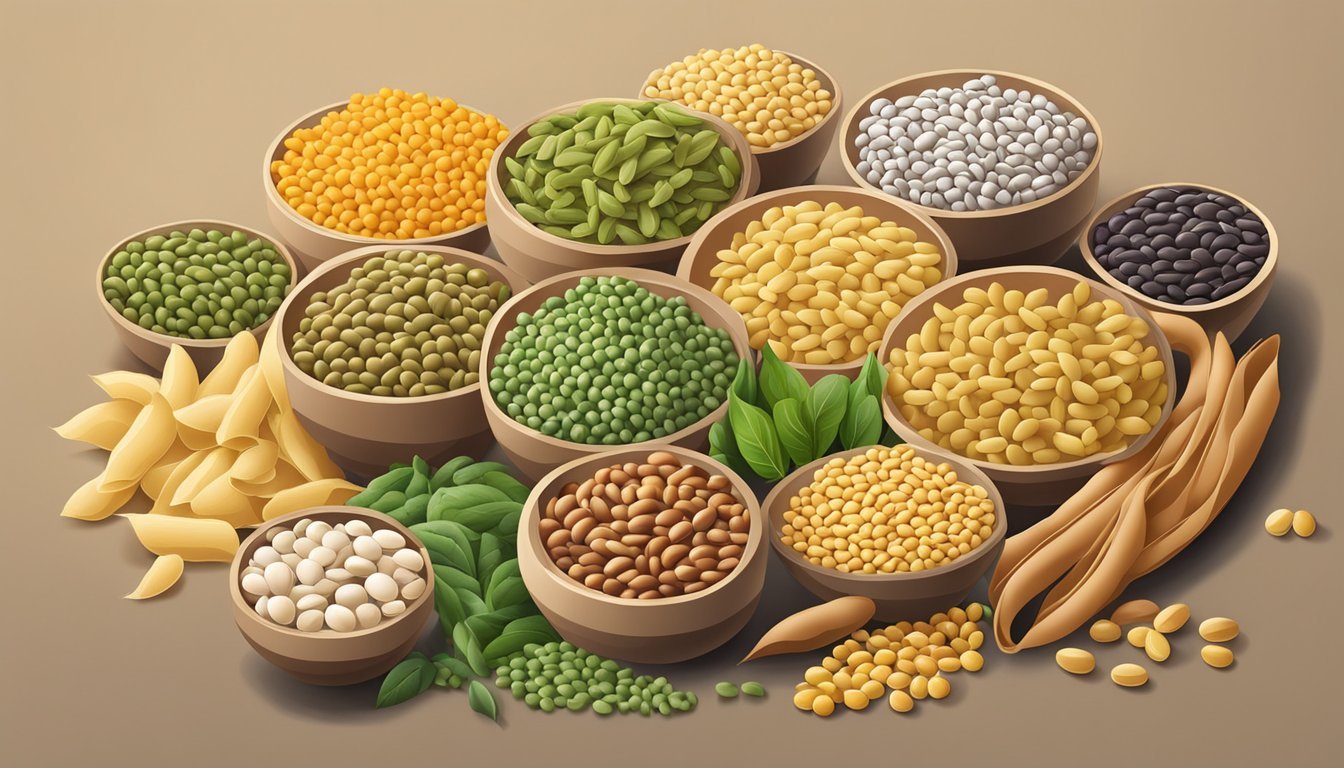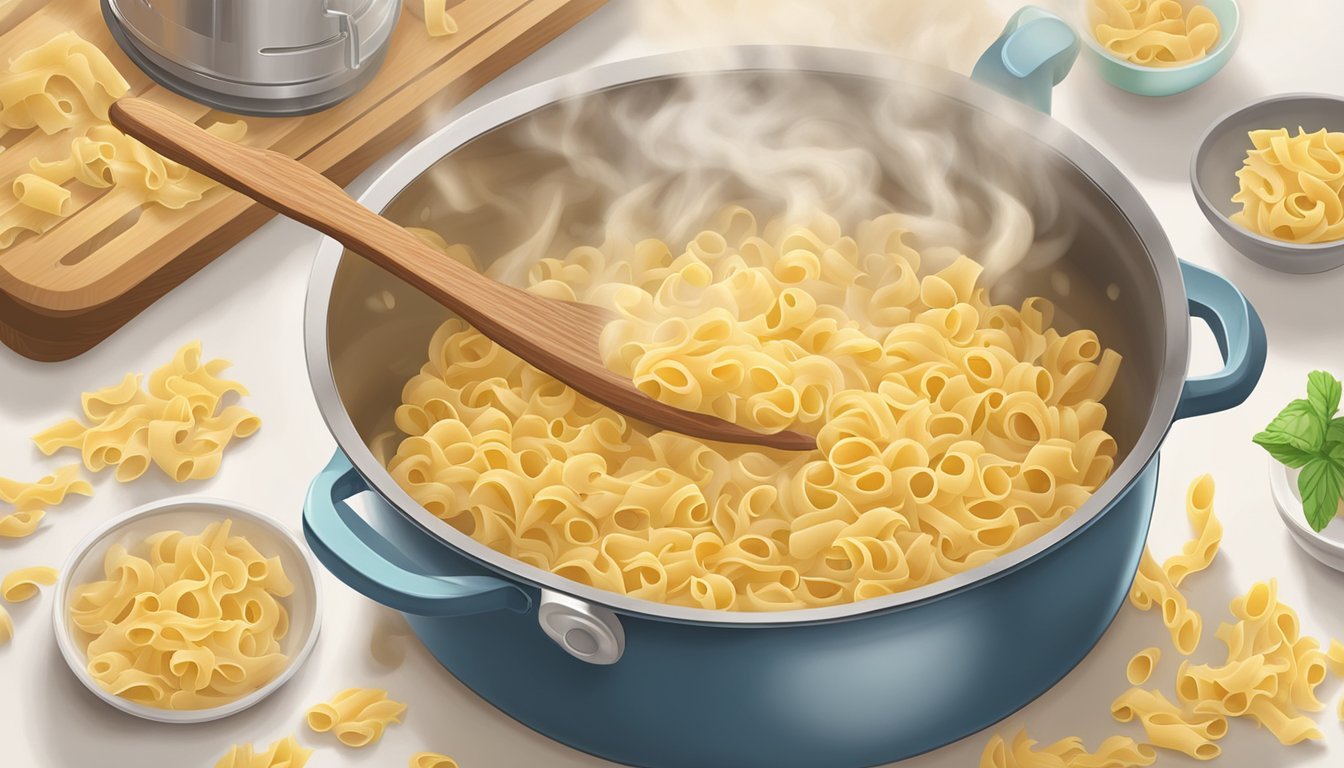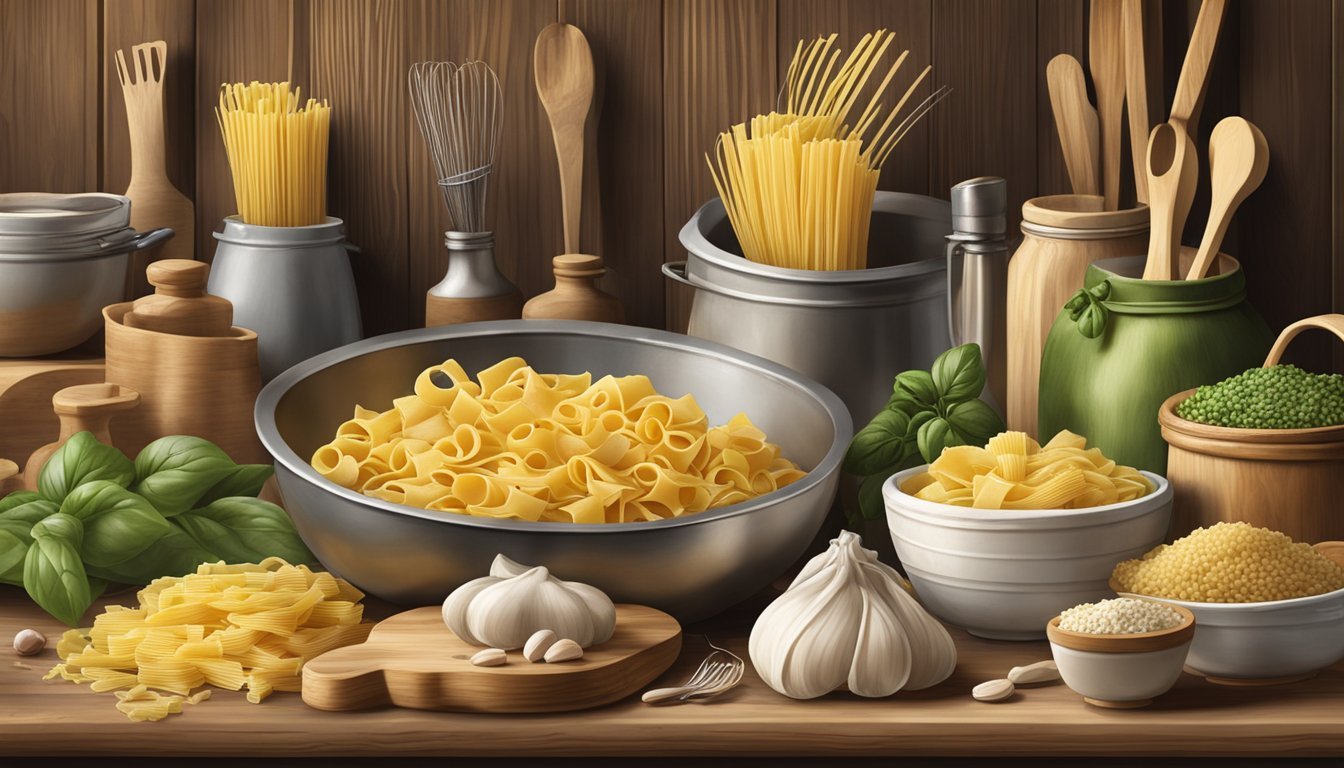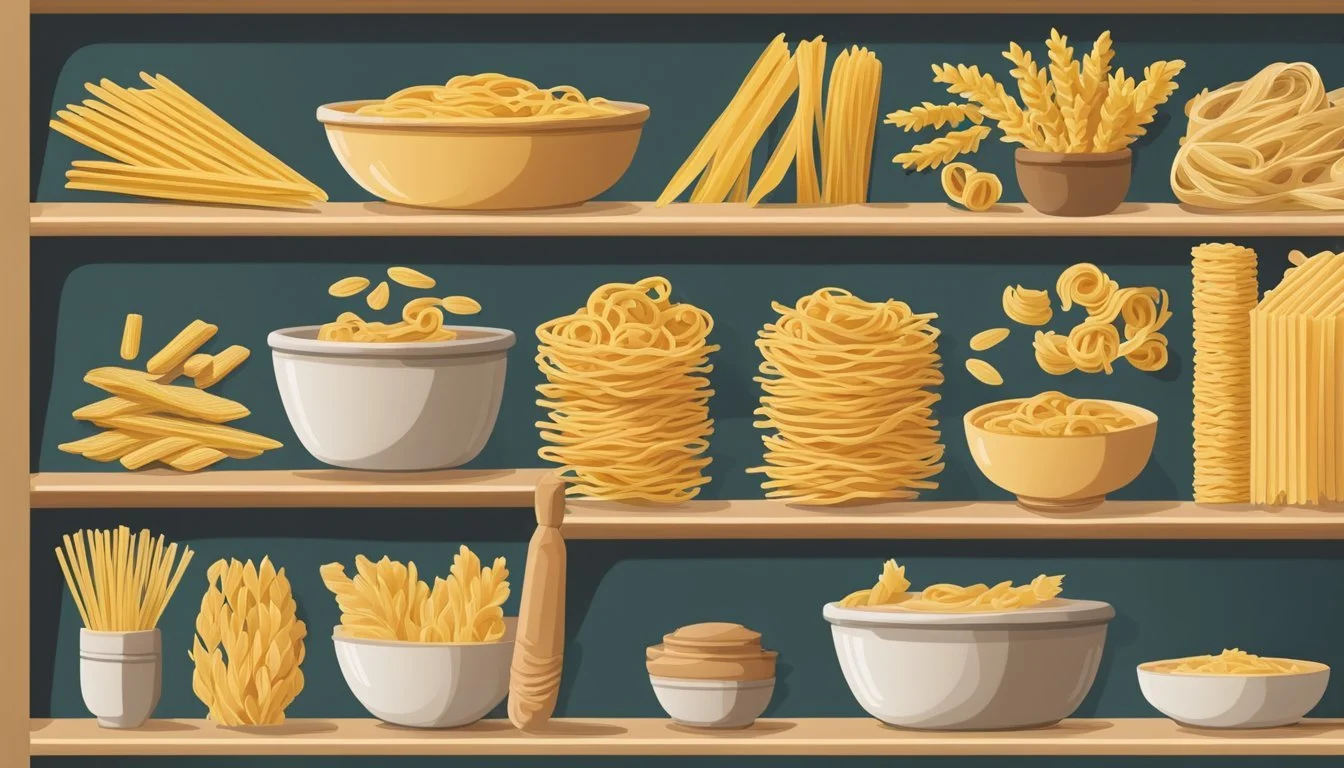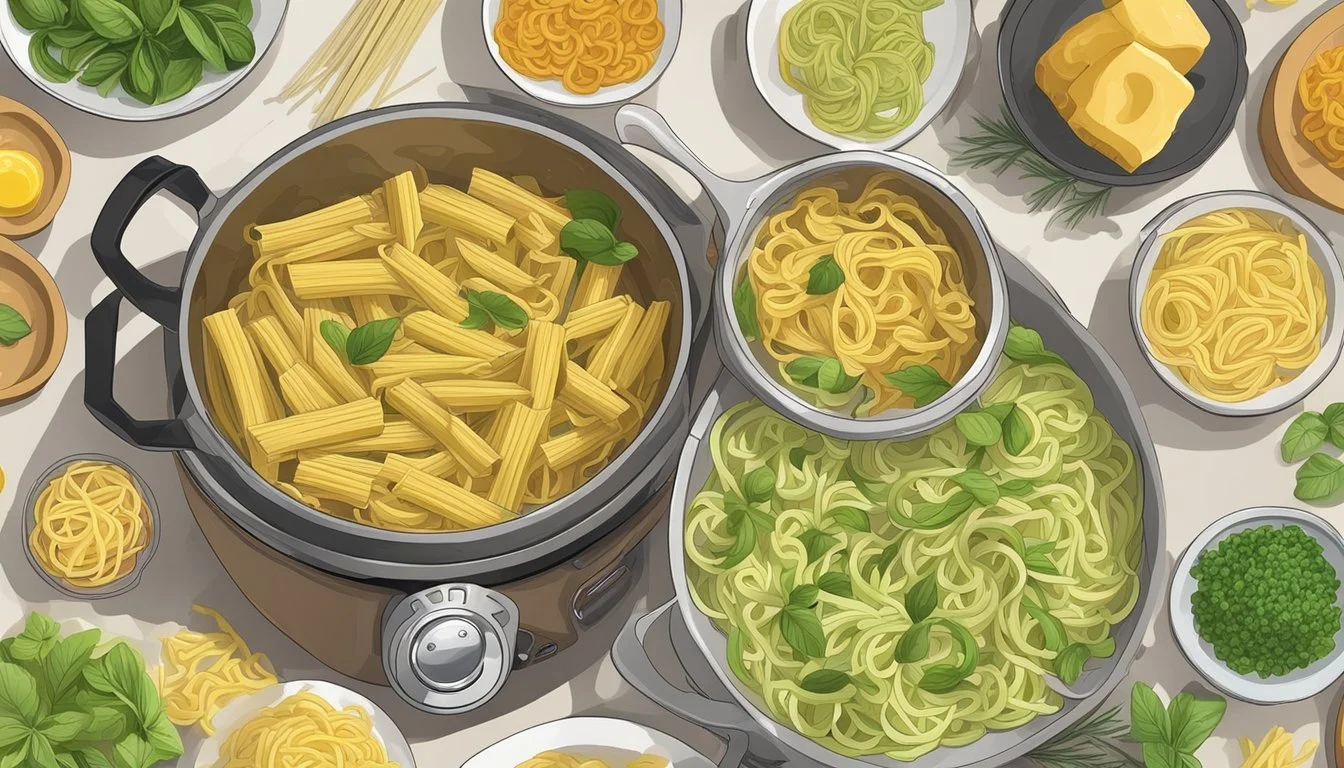Rigati Pasta Substitutes
Top Alternatives for Your Dishes
Rigati pasta (What wine goes well with pasta?), with its ridges and grooves, is superb for holding onto sauces, making it a staple in many Italian dishes. However, sometimes rigati isn't available, or diners are seeking a gluten-free or lower-carb option. Finding an appropriate substitute for rigati pasta can be a straightforward process, as several alternatives exist that replicate its ability to sop up and retain flavorful sauces.
The choice of pasta substitute largely depends on the type of dish being prepared and the desired texture. When rigati pasta isn't an option, alternatives like penne, fusilli, and rotini can provide a similar experience. These pastas also have ridges and can support a variety of sauces, making them ideal for recipes that typically call for rigati. Each substitute carries the sauce differently and can add distinct texture and flavor dimensions to a dish.
For those looking for healthier alternatives or with dietary restrictions, whole wheat pasta, quinoa (What wine goes well with quinoa?) pasta, and even legume-based pastas are available. These options not only mimic the texture and sauce-carrying benefits of traditional pasta but also offer additional nutritional value. It is important to consider the cooking times and individual characteristics of these substitutes to ensure they complement the overall dish.
Identifying Rigati Pasta Characteristics
Rigati pasta, a variant within the extensive pasta family, is distinguished by its form and contours. One will find its versatility pronounced in various cuisines, unlocked by its distinctive shape and ability to pair with a myriad of flavors and textures.
Shape and Texture
Rigati is a tube-shaped pasta that is not only functional in its design but also aesthetically pleasing. The surface is characterized by ridges that run down its length, enhancing not only its unique texture but also its ability to adhere to sauces. The ridges add an extra dimension to every bite, making it a formidable choice for dishes that require the pasta to capture and hold rich flavors. In cross-section, one will observe a hollow center that allows the pasta to maintain an al dente texture consistently throughout.
Common Uses in Cuisine
This pasta shines across various applications in Italian cuisine, where it exemplifies versatility. Rigati is often favored in hearty pasta bakes due to its texture that holds up well against prolonged cooking. Beyond its application in baked dishes like macaroni and cheese, it is also a staple in soupy concoctions such as minestrone soup and pasta e fagioli. Its robustness makes it an ideal candidate for soups, salads, and casseroles, where it provides a satisfying chewiness.
Flavor Profile
When considering the flavor profile of rigati pasta, it's much like a blank canvas, ready to harmonize with a wide range of ingredients. It mingles seamlessly with the sharp richness of cheese, the simplicity of butter, and the fruitiness of olive oil. Rigati’s ridged texture also means it pairs delightfully with both light and hearty sauces, from a simple tomato sauce to more elaborate creamy sauces and tangy marinara. The pasta's mild flavor allows it to absorb and amplify the flavors of the sauces and accompaniments, such as vegetables, meats, and herbs, with which it is served.
Pasta Substitute Essentials
When seeking alternatives to Rigati pasta, it's crucial to consider both the culinary and nutritional implications to ensure the substitute meets the desired needs.
Defining Pasta Substitutes
Pasta substitutes come in various forms, aiming to mimic the texture and shape of traditional pasta while providing different flavor profiles or nutritional benefits. Ditalini pasta, a small tube-like pasta often used in soups, can be substituted with similar shaped pasta such as corallini or elbow macaroni, offering a versatile range of textures for different dishes. These alternatives maintain the structural integrity of dishes like pasta salads and soups where Rigati or ditalini would usually be used.
Versatile Substitutes:
Corallini: Ideal for broths and adds delicate texture to soups.
Elbow Macaroni: Common in pasta salads and baked dishes.
Health and Dietary Considerations
Health-conscious diners or individuals with dietary restrictions often look for pasta substitutes to fulfill their gluten-free, high fiber, or high protein needs. Whole wheat pasta provides a higher content of nutrients and fiber, while still maintaining a semblance to traditional pasta in terms of taste and texture.
For those requiring gluten-free options, substitutes such as rice noodles or quinoa pasta could be a suitable alternative, as they offer comparable textures to regular pasta and are often enriched with additional nutrients. It's important to note that the nutritional profile of pasta substitutes can drastically vary from that of traditional pasta.
Gluten-Free Alternatives:
Rice Noodles: Light and versatile, perfect for various cuisines.
Quinoa Pasta: Rich in protein and offers a texture akin to traditional pasta.
Fiber and Protein-Rich Options:
Brown Rice Pasta: A good source of fiber, offering a similar experience to regular pasta.
Whole Wheat Pasta: Higher in fiber and nutrients compared to standard pasta.
Grain-Based Alternatives
In exploring grain-based alternatives to Rigati pasta, one finds a wealth of options ranging from traditional substitutes to more innovative choices stemming from specialty grains and seeds. These alternatives not only provide variety but also cater to specific dietary needs and flavor profiles.
Traditional Pasta Alternatives
Ditalini and Orzo: Small in stature yet versatile, ditalini and orzo serve as excellent replacements for Rigati in soups and salads. Their firm texture holds up well during cooking and their shapes are well-suited for dishes that require a pasta with substance.
Whole Wheat Pastas: Including whole wheat variations of penne, farfalle, and rigatoni, these alternatives offer a robust, nutty flavor along with additional fiber and nutrients. An easy swap in any recipe, whole wheat pasta maintains a similar cooking time and texture to Rigati.
Classic Shapes: Macaroni, ziti, and other classic pasta shapes can also substitute for Rigati. Each shape brings its unique twist to a dish, whether it's the tubular hold of ziti or the curl of macaroni, ideal for catching sauce.
Specialty Grains and Seeds
Quinoa Pasta: Quinoa pasta stands out with its high protein content and distinct, nutty taste. Its sturdy structure is particularly adept at capturing sauces, making it a formidable contender for pasta dishes (What wine goes well with pasta dishes?) that demand robustness akin to Rigati.
Grain Flavor Notes Ideal Use Case Quinoa Nutty, earthy Gluten-free pasta dishes Barley Chewy, rich Soups, cold salads
Barley: Not typically found in pasta form, barley can nonetheless replace pasta in certain recipes. Its chewy texture and rich flavor complement hearty meals and it’s especially good in soups or cold salads where pasta would traditionally be used.
Vegetable-Based Substitutes
When considering vegetable-based substitutes for Rigati pasta, one finds two broad categories: starchy and non-starchy options. These alternatives offer a nutritional boost and a unique taste experience that can complement various sauces and flavors in pasta dishes.
Starchy Vegetable Options
Starchy vegetables like butternut squash and spaghetti squash can serve as satisfying substitutes for Rigati pasta. The naturally sweet flavor and hearty texture of butternut squash make it an excellent base for more robust sauces. One can transform spaghetti squash by baking and then forking out its threads to create a pasta-like shape, ready to absorb the flavors of traditional Italian seasonings or creamy sauces.
Butternut Squash: Cube, steam, and blend as a puree, or slice into ribbons to mimic noodle strands.
Spaghetti Squash: Bake, then shred into spaghetti-like strands with a fork for a low-calorie, gluten-free option.
Non-Starchy Vegetable Choices
Non-starchy vegetables such as zucchini, eggplant, and broccoli offer a lighter alternative to traditional pasta. One can spiralize zucchini into noodles, known as "zoodles," which provide a delicate and slightly crunchy counterpart to pasta. Eggplant can be sliced thinly and used as a lasagna noodle replacement. Broccoli, when cut into small florets and lightly steamed, adds a crunchy texture and a boost of nutrients to any pasta dish.
Zucchini Noodles (Zoodles): Spiralize for a quick and easy pasta alternative that cooks in minutes.
Eggplant: Thinly slice and layer in place of lasagna noodles for a flavorful and fiber-rich option.
Broccoli: Chop into small florets, steam, and toss with your favorite sauce for added texture and nutrition.
Legume and Bean Alternatives
When exploring alternatives to traditional rigati pasta, legume and bean variants stand out due to their nutritional benefits. These pastas are typically made from lentils, chickpeas, black beans, or other beans, providing a substantial increase in protein and fiber content compared to regular pasta.
Lentil Pasta: It often contains around 11 to 15 grams of protein per serving. Lentil pasta is also rich in fiber, supporting digestive health. Lentils bring a robust, slightly peppery flavor to dishes.
Chickpea Pasta: A popular choice that delivers both protein and nutrients. Chickpea pasta typically has about 14 grams of protein per serving and includes fiber and essential vitamins and minerals.
Black Bean Pasta: Rich in protein and fiber, black bean pasta can offer upwards of 15 grams of protein per serving. They are also an excellent source of iron and antioxidants, with the dark color indicating the presence of flavonoids.
Here's a quick comparative overview:
Type Protein per Serving Fiber Notable Nutrients Lentil Pasta 11-15g High Iron, Folate Chickpea Pasta ~14g High Vitamins B6, Potassium Black Bean Pasta >15g High Iron, Flavonoids, Calcium
These alternatives provide the body with essential amino acids, making them excellent for muscle repair and general health. They're especially advantageous for those following vegetarian or vegan diets. The flavors are distinct yet versatile, pairing well with a variety of sauces and vegetables.
Cooking Methods and Textural Considerations
Selecting an appropriate substitute for Rigati Pasta involves matching the cooking methods to achieve a texture that closely mimics the original pasta's bite and feel.
Achieving Desired Texture
When substituting for Rigati Pasta, texture is a pivotal factor. The goal is to maintain the al dente quality, a term that translates to "to the tooth" in Italian. This term describes pasta that is cooked to be firm to the bite. Achieving this relies on careful timing and the correct method of boiling.
Each pasta alternative will respond differently to boiling, some requiring longer cooking times than others. For example:
Rice noodles: Softer texture; quickly become tender, requiring brief boiling time.
Whole-wheat pasta: Heartier texture; longer boiling time for al dente texture.
Cooking Substitutes
Various cooking techniques can be employed to prepare pasta substitutes:
Boiling: The most traditional method. It's essential to constantly test the pasta near the end of the cooking time to prevent overcooking.
Pasta Type | Boiling Time | Texture Achieved
--- | --- | ---
Rice Noodles | 3-5 min | Silky, slippery
Whole-wheat Pasta | 9-12 min | Firm, grainy
Baking: Suitable for oven-ready pasta substitutes, which often require a pre-bake in sauce for moisture and tenderness.
Sautéing: Some alternatives, like zucchini noodles, benefit from a quick sauté rather than boiling to retain a texture that doesn’t become too soft.
By combining these methods with an understanding of the substitute's textural properties, one can closely replicate the Rigati Pasta experience.
Flavor Pairings and Sauce Integration
When selecting a substitute for Rigati pasta, one must consider how the flavor pairings and sauce integration will complement the overall dish.
Matching Flavors
To replicate the flavor profile of Rigati pasta dishes:
Sauces: A robust tomato sauce with herbs and spices like basil and oregano is ideal. For a twist, a Marinara sauce, made with high-quality tomatoes, garlic, olive oil, and a pinch of salt and pepper, can enhance the dish's flavor.
Cheese: Incorporating cheeses such as Parmesan can add a nutty and umami-depth to pasta dishes, especially when blended with creamy sauces.
Olive Oil: A drizzle of olive oil can provide a fruity undertone and is vital for emulsifying and enriching sauces.
Sauce Absorption and Consistency
The choice of pasta affects the dish's final texture and sauce adherence:
Tubular Shapes: Substitutes with similar tube shapes, such as Penne or Ziti, are recommended for their sauce-holding capabilities, which are akin to Rigati's ridges.
Creamy Sauces: For cream-based sauces such as Alfredo, opt for substitutes that offer a surface area that can carry the creamy texture without overwhelming the palate.
Creative Recipe Ideas
In the quest for delicious meals, creative uses of pasta can invigorate classic dishes or introduce new favorites. This section explores various recipe ideas, integrating rigatoni substitutes across a spectrum of dishes to enhance flavors and textures.
Innovative Salad Creations
One can transform the typical pasta salad into a refreshing delight with corallini. They bring a satisfying bite to a Mediterranean-inspired salad mixed with cherry tomatoes, cucumbers, feta, and a tangy vinaigrette.
Comforting Soups and Stews
Tiny pasta varieties like corallini are perfect for adding substance to Minestrone soup, without overpowering the rich tomato base and medley of vegetables. For stews, using a small pasta can add a pleasant texture to each spoonful, soaking up the hearty flavors.
Baked Delights
When making a pasta bake, substituting rigatoni with similar tube-shaped pasta offers the same cheese-holding capacity. In a four-cheese sausage bake, layers of mozzarella, ricotta, and Parmesan wrap around each piece, ensuring every bite is as comforting as the last.
Refreshing Vegetarian and Vegan Options
For those seeking vegetarian or vegan meals, incorporating smaller pasta shapes can make a dish feel lighter yet satisfying. Pairing pasta with sautéed veggies and a robust marinara creates a simple, yet delicious, vegan-friendly option.
High-Protein and Low-Carb Dishes
For a high-protein, low-carb twist, one could incorporate lentil or chickpea pasta into a traditional macaroni and cheese recipe. These substitutes bring a nutritious protein punch and a unique flavor profile that complements the classic cheesy goodness.
Selecting the Right Substitute
When searching for a rigati pasta substitute, it's essential to consider factors such as shape, texture, and dietary needs to ensure the integrity of the pasta dish is maintained.
Similar Pasta Shapes
To match rigati pasta, which is known for its ridged surface, one can consider similar cylindrical pasta like tubettini or tubetti, which offer ridges for sauce adherence. For smaller ridged options, corallini or ditalini maintain a similar aesthetic and function in dishes that require less heft. If a soup calls for rigati, orzo, resembling rice grains, or acini di pepe, mimicking peppercorns, work well as they create a pleasing mouthfeel while preserving the dish's consistency.
Texture and Firmness
For the desired al dente texture, substitutes must not only resemble rigati in shape but also in cooking firmness. Orzo and ditalini, able to achieve a firm bite, are suitable for maintaining that al dente experience. When preparing baked dishes or salads where rigati's firmness is prominent, one should opt for tubettini or even conchiglie (shells) as they hold their shape well under heat and mixed with other ingredients.
Dietary Needs and Preferences
One should not overlook dietary needs when selecting a substitute for rigati pasta. For those with gluten-free dietary restrictions, choosing alternatives like corn or rice-based pasta can be crucial. Whole wheat pasta provides a similar texture to rigati and can be found in comparable shapes such as tubetti or conchiglie for those seeking more fiber. If a unique texture is not a crucial factor, alphabet pasta or ring-shaped pasta like anellini may cater to those focusing on a fun shape rather than the ridged texture of rigati.
Tips for Cooking Pasta Substitutes
When venturing into the world of pasta substitutes, one must pay attention to cooking methods to achieve the best texture and flavor. Different substitutes require unique approaches to mirror the beloved al dente texture of traditional pasta.
Rice Noodles: These require a delicate touch. They should be soaked in warm water until pliable and then cooked for a few minutes in boiling water. Overcooking will make them mushy, so it's essential to taste test frequently.
Shirataki Noodles: These Japanese noodles are almost entirely fiber. They come precooked and only need to be rinsed thoroughly and then heated through, which can be done quickly in a pan or through a brief boil.
Kelp Noodles: With these, boiling isn't necessary. They are usually ready to eat out of the package and only need to be rinsed in warm water. If a softer texture is desired, they can be soaked in lemon juice or vinegar prior to preparation.
When using pasta substitutes, one might consider adding a dash of olive oil in the water or the dish to prevent sticking and enhance flavor. Here are some general guidelines for cooking substitutes:
Before Cooking: Rinse thoroughly under cold water if needed (especially for shirataki noodles).
Boiling: Use ample water and stir occasionally to prevent clumping.
Testing for Doneness: Start checking a few minutes before the suggested cooking time to avoid overcooking.
Finishing Touch: Drain well and toss with your preferred sauce or ingredients promptly after cooking to prevent sticking.
Keep in mind that cooking times may vary, and close attention is the best way to ensure substitutes are served with an excellent texture and are neither too firm nor too soft, but just right.
Conclusion
In the realm of Italian pasta, rigati stands out with its ridged surface, ideal for gripping sauces and enhancing the flavor of numerous dishes. However, when rigati is not available, there are several substitutes that can be considered. Penne, with its similar tube shape and ridges, makes an excellent alternative, particularly in recipes where the texture and sauce adherence are crucial.
For smaller pasta shapes, one might consider ditalini or orzo, both adept at complementing the mouthfeel that rigati provides. These alternatives are also a wise choice for soups or salads where a more diminutive pasta is preferred. It’s important to note that each substitute may have a slightly different cooking time, so adjustments should be made accordingly to achieve the desired al dente texture.
Pasta Type Best Used In Note Penne Hearty sauces, bakes A direct substitute, excellent for layering Ditalini Soups, stews Smaller, yet holds shape well in broths Orzo Salads, light broths Rice-shaped, offers a novel look
When one seeks to diversify their culinary endeavors or simply has to utilize what's available in the pantry, these pasta substitutes offer a seamless transition. Replace rigati with one of these alternatives to maintain the integrity and essence of the original Italian dish being prepared. Choosing the appropriate pasta substitute ensures that the desired flavors and textures will still present themselves proudly on the plate.


